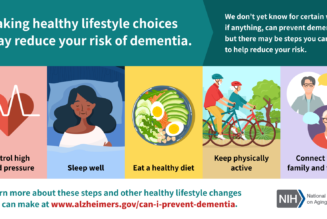
Good health can allow you to fully participate in the activities you enjoy and live life to the fullest. Yet many Americans struggle with chronic health conditions that hamper their quality of life. Six in 10 American adults have at least one chronic disease and four in 10 have two or more, according to the Centers for Disease Control and Prevention (CDC).
The CDC defines a chronic disease as a condition that lasts at least a year and requires ongoing medical attention or can inhibit daily life—or both.
Unfortunately, the rate of chronic disease is projected to increase over the next few decades. Between 2025 and 2060, the number of Americans with diabetes is expected to increase by 39.3%, hypertension by 27.2% and obesity by 18.3%, according to the Journal of the American College of Cardiology.
Some states have higher rates of chronic disease than others, in part due to unhealthy lifestyles and high substance abuse.
To determine which states have the healthiest and least healthy populations, Forbes Advisor compared all 50 states across 21 metrics spanning three categories: disease risk factors and prevalence, substance abuse, lifestyle habits and health outlook.
The results reveal which states have the least healthy populations based on high rates of chronic disease, drug abuse and unhealthy lifestyle habits. If you live in one of these states, take action to improve your health by making lifestyle changes and taking advantage of preventive care. Your health is your most valuable asset.
Related: Best Life Insurance Companies For Diabetics
Key Takeaways
- West Virginia tops the list of states with the least healthy populations, while Hawaii ranks as the state with the healthiest residents.
- Eight of the top 10 least healthy states are in the South: West Virginia, Mississippi, Tennessee, Arkansas, Kentucky, Alabama, Louisiana and Oklahoma.
- Five of the top 10 healthiest states are on the East Coast: Connecticut, Massachusetts, New Jersey, New Hampshire and New York.
- Mississippi ranks worst overall in our disease risk factors and prevalence category, West Virginia residents have the worst lifestyle habits and health outlook and Vermont is the worst state for substance abuse.
Top 5 Least Healthy States
1. West Virginia
West Virginia’s score: 100 out of 100
West Virginia is the most unhealthy state in America, based on our analysis. The Mountain State ranks worst overall in our lifestyle habits and health outlook category.
West Virginia’s sobering statistics include:
- Highest percentage of adults who smoke (21%).
- Highest percentage of obese adults (41%).
- Second shortest life expectancy (73.9 years).
- Third highest percentage of adults who did not exercise in the past month (30.2%).
West Virginia also ranks second worst in our disease risk factors and prevalence category. West Virginia stands out as the state with the:
- Highest percentage of adults with high cholesterol (41%).
- Highest diabetes mortality rate (41.7 deaths per 100,000 state residents).
- Second highest kidney disease mortality rate (21.07 deaths per 100,000 state residents).
- Second highest cancer mortality rate (178.9 deaths per 100,000 state residents).
- Second highest percentage of adults with high blood pressure (43.4%).
- Third highest percentage of adults with diagnosed diabetes (13.1%).
- Third highest chronic lower respiratory disease mortality rate (60.07 deaths per 100,000 state residents).
- Fifth highest hypertension mortality rate (12.33 deaths per 100,000 state residents).
Out of all 50 states, West Virginia also had the highest drug overdose death rate (75.03 per 100,000 state residents), more than 50% higher than the second-worst state (Delaware).
2. Mississippi
Mississippi’s score: 96.04 out of 100
The Magnolia State ranks worst overall in our category assessing disease risk factors and prevalence. Mississippi has the highest hypertension rates in the country, with 43.9% of adults having high blood pressure. This puts many residents at increased risk of heart disease and stroke.
The state also has the highest percentage of adults diagnosed with diabetes, at 13.7%. Uncontrolled diabetes can lead to serious health complications, including heart and kidney disease.
Additionally, Mississippi stands out as the state with the:
- Highest cancer mortality rate (178.97 deaths per 100,000 state residents).
- Highest hypertension mortality rate (17.37 deaths per 100,000 state residents).
- Highest kidney disease mortality rate (21.8 deaths per 100,000 state residents).
- Highest stroke mortality rate (54.8 deaths per 100,000 state residents).
- Second highest rate of both diabetes deaths (38.53 deaths per 100,000 state residents) and heart disease deaths (242.5 deaths per 100,000 state residents).
- Fifth highest chronic lower respiratory disease mortality rate (58.4 deaths per 100,000 state residents).
- Fifth highest percentage of adults with high cholesterol (38.3%).
For lifestyle habits and health outlook, Mississippi performs second worst nationwide. It has the shortest life expectancy nationwide (73.63 years). And Mississippi adults were most likely to report they did not exercise in the past month (31.9%).
The state also has the fourth highest obesity rates (39.5% of adults) and smoking rates (17.4%, tied with Kentucky).
3. Tennessee
Tennessee’s score: 94.39 out of 100
Tennessee ranks fourth worst in both our lifestyle habits and health outlook category and our substance abuse category. Tennessee has the highest rate of opioid misuse (3,743.97 per 100,000 adults) and prescription pain reliever misuse (3,190.88 per 100,000 adults) in the country. This indicates a major opioid epidemic in the state.
Tennessee also stands out as the state with the:
- Third highest percentage of adults who smoke (18.5%).
- Fifth highest drug overdose death rate (44.47 deaths per 100,000 state residents).
- Fifth highest percentage of obese adults (38.9%).
- Sixth highest percentage of adults who did not exercise in the past month (27.7%).
Additionally, Tennessee has the sixth shortest life expectancy in the U.S. at just 74.97 years.
For disease risk factors and prevalence, it performs fifth worst overall with these metrics:
- Fifth highest cancer mortality rate (165.9 deaths per 100,000 state residents, tied with Arkansas).
- Sixth highest heart disease mortality rate (212.87 deaths per 100,000 state residents).
- Sixth highest percentage of both adults with diagnosed diabetes (12.2%) and adults with high cholesterol (38%).
- Seventh highest diabetes mortality rate (29.13 deaths per 100,000 state residents).
- Eighth highest rate of both hypertension deaths (11.53 deaths per 100,000 state residents) and chronic lower respiratory disease deaths (51.9 deaths per 100,000 state residents).
4. Arkansas
Arkansas’ score: 88.06 out of 100
Arkansas ranked third worst for disease risk factors and has very high mortality rates for leading causes of death like heart disease, cancer, diabetes and respiratory disease.
Arkansas stands out as the state with the:
- Second highest chronic lower respiratory disease mortality rate (60.7 deaths per 100,000 state residents).
- Third highest diabetes mortality rate (34.3 deaths per 100,000 state residents).
- Fourth highest heart disease mortality rate (226.67 deaths per 100,000 state residents).
- Fourth highest percentage of adults with high blood pressure (40.7%).
- Fifth highest cancer mortality rate (165.9 deaths per 100,000 state residents, tied with Tennessee).
- Sixth highest rate of both kidney disease deaths (18.87 deaths per 100,000 state residents) and stroke deaths (44.7 deaths per 100,000 state residents).
In terms of lifestyle habits and health outlook, Arkansas performs seventh worst overall. The state is home to the second highest percentage of adults who smoke (18.7%). Also, Arkansas adults were second most likely to report that they did not exercise in the past month (31.2%).
To top it off, the Natural State has the seventh shortest life expectancy (75.03 years) and is the second worst state for opioid misuse among adults, with 3,447.55 per 100,000 state residents reporting opioid misuse within the past year. It also has the second highest number of adults who report prescription pain reliever misuse in the past year (3,119.22 per 100,000 state residents).
5. Kentucky
Kentucky’s score: 87.46 out of 100
The Bluegrass State rounds out our list as the fifth least healthy state. Kentucky ranks sixth worst for both disease risk factors and prevalence and lifestyle habits and health outlook.
Kentucky stands out as the state with the:
- Third highest cancer mortality rate (178.27 deaths per 100,000 state residents).
- Third highest drug overdose death rate (45.77 deaths per 100,000 state residents).
- Fourth highest chronic lower respiratory disease mortality rate (58.7 deaths per 100,000 state residents).
- Fourth shortest life expectancy (74.77).
- Fourth highest percentage of adults who smoke (17.4%, tied with Mississippi).
- Fifth highest percentage of adults with diagnosed diabetes (12.3%).
- Sixth highest diabetes mortality rate (29.77 deaths per 100,000 state residents).
- Sixth highest percentage of adults with high blood pressure (39.9%).
Additionally, Kentucky has the seventh highest rate of both heart disease deaths (206.13 deaths per 100,000 state residents) and kidney disease deaths (18.5 deaths per 100,000 state residents).
Top 5 Healthiest States
1. Hawaii
Hawaii’s score: 0 out of 100
According to our research, Hawaii is the healthiest state in the US. It ranks best overall for having low disease risk factors and healthy lifestyle habits.
The Aloha State boasts the:
- Lowest chronic lower respiratory disease mortality rate (17.83 deaths per 100,000 state residents).
- Longest life expectancy nationwide (80.87 years).
- Second lowest percentage of obese adults (25.9%).
- Second lowest heart disease mortality rate (123.93 deaths per 100,000 state residents).
- Second lowest cancer mortality rate (125.5 deaths per 100,000 state residents).
- Second lowest chronic liver disease mortality rate (8.37 deaths per 100,000 state residents).
- Third lowest diabetes mortality rate (16.83 deaths per 100,000 state residents).
- Sixth lowest percentage of adults who smoke (10%, tied with Connecticut and Washington).
Hawaii also ranks second best in our substance abuse category. The state reported the lowest alcohol-induced death rate of any other state (7.37 deaths per 100,000 state residents).
Hawaii also stands out as the state with the:
- Fifth lowest number of adults who report illicit drug use in the past month (8,332.2 per 100,000 state residents).
- Ninth lowest drug overdose death rate (17.17 deaths per 100,000 state residents).
- 10th lowest number of adults who report opioid misuse in the past year (2,291.35 per 100,000 state residents).
2. Utah
Utah’s score: 11.34 out of 100
Trailing just behind Hawaii is Utah. As the second healthiest state, it has the fourth lowest percentage of adults who are heavy drinkers (5%), and the fourth lowest number of adults who report illicit drug use in the past month (8,075.01 per 100,000 state residents).
Utah also ranks sixth best in our category assessing lifestyle habits and health outlook. It’s home to the lowest percentage of adults who smoke (6.7%). Utah adults were second least likely to report that they did not exercise in the past month (16.9%).
When it comes to disease risk factors, the Beehive State ranked seventh best in this category.
Utah boasts the:
- Lowest cancer mortality rate (119.23 deaths per 100,000 state residents).
- Second lowest percentage of adults with high blood pressure (26.6%).
- Fourth lowest percentage of adults with high cholesterol (31.6%).
- Sixth lowest chronic liver disease mortality rate (10.23 deaths per 100,000 state residents).
3. Connecticut
Connecticut’s score: 13.33 out of 100
Connecticut ranks as the third healthiest state, including third best for disease risk factors and prevalence. It has the:
- Lowest diabetes mortality rate (16.33 deaths per 100,000 state residents).
- Fourth lowest chronic lower respiratory disease mortality rate (25.33 deaths per 100,000 state residents.
- Fourth lowest stroke mortality rate (28.2 deaths per 100,000 state residents).
- Seventh lowest rate of both heart disease deaths (139.4 deaths per 100,000 state residents) and hypertension deaths (6.77 deaths per 100,000 state residents).
- Eighth lowest cancer mortality rate (133.07 deaths per 100,000 state residents).
Connecticut also ranks seventh best in our lifestyle habits and health outlook category. The state boasts the sixth longest life expectancy (79.7). It tied with Hawaii and Washington as having the sixth lowest percentage of adults who smoke (10%).
4. Minnesota
Minnesota’s score: 16.16 out of 100
The Land of 10,000 Lakes happens to also be the fourth healthiest state in the nation. It ranks fifth best in terms of disease risk factors and prevalence.
Minnesota has the lowest heart disease mortality rate of any other state (119.57 deaths per 100,000 state residents). It also has the second lowest percentage of adults with high cholesterol (31.4%).
The state also has these disease-related metrics:
- Fourth lowest kidney disease mortality rate (7.37 deaths per 100,000 state residents).
- Fourth lowest percentage of adults with high blood pressure (29.5%).
- Ninth lowest percentage of adults with diagnosed diabetes (7.9%).
- Ninth lowest chronic lower respiratory disease mortality rate (30.6 deaths per 100,000 state residents).
Additionally, Minnesota residents have the third longest life expectancy (80 years), as well as the fourth fewest adults who report opioid misuse in the past year (2,203.88 per 100,000 state residents).
5. Massachusetts
Massachusetts’ score: 17.02 out of 100
Massachusetts is the fifth healthiest state on our list, ranking second best in our disease risk factors and prevalence category.
Massachusetts boasts the:
- Second lowest diabetes mortality rate (16.6 deaths per 100,000 state residents).
- Second lowest stroke mortality rate (25.57 deaths per 100,000 state residents).
- Third lowest heart disease mortality rate (129.37 deaths per 100,000 state residents).
- Sixth lowest percentage of adults with diagnosed diabetes (7.8%).
- Seventh lowest rate of both chronic lower respiratory disease deaths (28.63 deaths per 100,000 state residents) and chronic liver disease deaths (10.3 deaths per 100,000 state residents).
Massachusetts ranked as the fourth best state for lifestyle habits and health outlook. Metrics in this category include:
- Fourth lowest percentage of obese adults (27.2%).
- Fourth longest life expectancy (79.83 years).
- Eighth lowest percentage of adults who smoke (10.4%).
How Health Impacts Life Insurance Rates
Your health can significantly impact how much life insurance costs. Insurance companies assess your medical history and health risks when pricing your policy, so maintaining good health can lower your premiums.
When getting life insurance quotes, the insurer will likely require a medical exam for policies over a certain amount, except when you’re getting no-exam life insurance. The examiner checks your vitals including blood pressure, cholesterol levels and nicotine use. Conditions like high blood pressure, heart disease and diabetes can increase premiums.
For cheap life insurance or for tips on how to pass a life insurance exam, focus on improving any health issues. Eat healthy, exercise regularly, quit smoking and reduce alcohol use. Controlling chronic illnesses can also help.
There are many factors affecting life insurance premiums, and nicotine is one of the biggest ones. Life insurance for smokers costs significantly more than for non-smokers—sometimes double the price. Kicking the habit for at least 12 months can lower rates.
Your weight, body mass index (BMI) and cholesterol levels are also factored in. Being overweight or obese can increase premiums. Losing weight, eating well and exercising can help counteract this.
Insurers also ask about any family history of major illnesses like cancer, heart disease or stroke. While you can’t change genetics, focus on reducing lifestyle risks through diet, exercise and regular checkups.
For many people, life insurance is worth it. Comparing types of life insurance and policies can also help find the best life insurance at an affordable rate.
With some diligence, you can find an affordable rate for the amount of life insurance you need, even with health conditions. Just accurately disclose your medical history and health status when applying. Being upfront prevents issues later on if you need to file a life insurance claim.
Compare Life Insurance Companies
Compare Policies With 8 Leading Insurers
Related Content:
- Life Insurance Statistics
- The Most Expensive States To Die In, Ranked
- States With The Most And Least E-Cigarette Use
Methodology
To determine which states have the healthiest and least healthy populations, Forbes Advisor compared all 50 states across three key categories: disease risk factors and prevalence, substance abuse and lifestyle habits and health outlook.
We considered 21 relevant metrics, which are listed below with their corresponding weights:
Disease Risk Factors and Prevalence – Total Points: 61.5
- Cancer mortality rate per 100,000 state residents: 6% of score. Data comes from the CDC. For this metric, we took a three year average, using data from 2019 to 2021.
- Diabetes mortality rate per 100,000 state residents: 6% of score. Data comes from the CDC. For this metric, we took a three year average, using data from 2019 to 2021.
- Heart disease mortality rate per 100,000 state residents: 6% of score. Data comes from the CDC. For this metric, we took a three year average, using data from 2019 to 2021.
- Hypertension mortality rate per 100,000 state residents: 6% of score. Data comes from the CDC. For this metric, we took a three year average, using data from 2019 to 2021.
- Kidney disease mortality rate per 100,000 state residents: 6% of score. Data comes from the CDC. For this metric, we took a three year average, using data from 2019 to 2021.
- Chronic Lower Respiratory Disease (CLRD) mortality rate per 100,000 state residents: 6% of score. CLRD includes chronic obstructive pulmonary disease (COPD), chronic bronchitis, emphysema, and asthma. Data comes from the CDC. For this metric, we took a three year average, using data from 2019 to 2021.
- Stroke mortality rate per 100,000 state residents: 6% of score. Data comes from the CDC. For this metric, we took a three year average, using data from 2019 to 2021.
- Chronic liver disease/cirrhosis mortality rate per 100,000 state residents: 6% of score. Data comes from the CDC. For this metric, we took a three year average, using data from 2019 to 2021.
- Percentage of adults with high cholesterol: 4.5% of score. Data comes from the CDC’s Behavioral Risk Factor Surveillance System (BRFSS), 2021.
- Percentage of adults with high blood pressure: 4.5% of score. Data comes from BRFSS, 2021.
- Percentage of adults with diagnosed diabetes: 4.5% of score. Data comes from the Kaiser Family Foundation (KFF), 2021.
Substance Abuse – Total Points: 25
- Alcohol-induced death rate per 100,000 state residents: 6% of score. Data comes from KFF. For this scoring factor, we took a three year average using data from 2019 to 2021.
- Drug overdose death rate per 100,000 state residents: 6% of score. Data comes from the CDC. For this metric, we took a three year average, using data from 2019 to 2021.
- Number of adults who report illicit drug use in the past month per 100,000 state residents: 3.25% of score. Data comes from The Substance Abuse and Mental Health Services Administration (SAMHSA), 2021.
- Number of adults who report opioid misuse in the past year per 100,000 state residents: 3.25% of score. Data comes from SAMHSA, 2021.
- Number of adults who report prescription pain reliever misuse in the past year per 100,000 state residents: 3.25% of score. Data comes from SAMHSA, 2021.
- Percentage of adults who are heavy drinkers: 3.25% of score. This metric reflects the percentage of adult men who have more than 14 drinks per week and the percentage of adult women who have more than 7 drinks per week. Data comes from BRFSS, 2022.
Lifestyle Habits and Health Outlook – Total Points: 13.5
- Life expectancy at birth: 5% of score. Data comes from the CDC. For this metric, we took a three year average using data from 2018 to 2020.
- Percentage of adults who report being obese: 3.25% of score. Data comes from the CDC, 2022.
- Percentage of adults who are current smokers: 3.25% of score. Data comes from BRFSS, 2022.
- Percentage of adults who did not exercise in the past month: 2% of score. Data comes from BRFSS, 2022.








